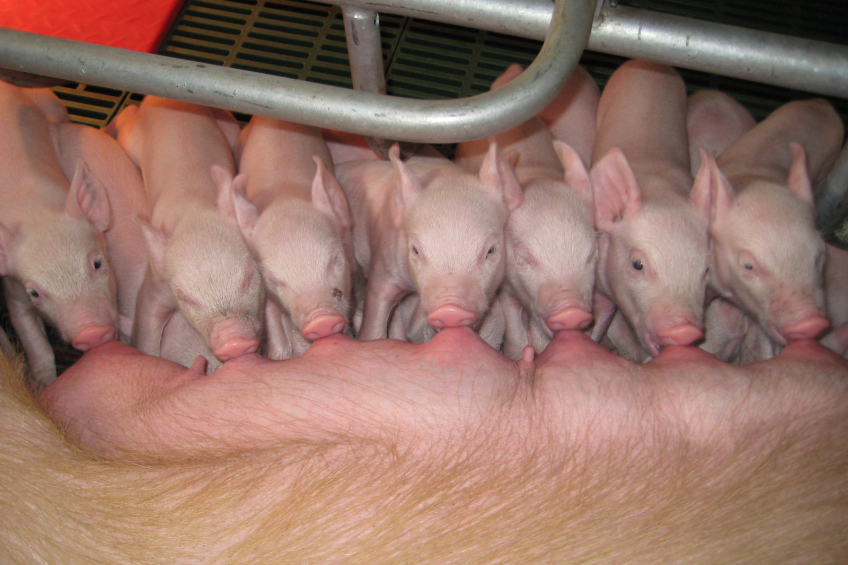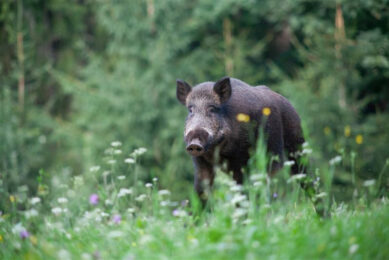Genomics and its impact on future pig breeding

Genome Wide Selection will most likely lead to more uniform genetic products.
The art of pig breeding is continuing at a rapid pace. Key to this is the thorough analysis of both function and structure of genomes – also known as ‘genomics’. Genotyping costs have decreased dramatically over the last decade. Improving pig breeds thus is becoming increasingly feasible for more and more traits. Where does that lead to in the future?
Predicting breeding values is a well-accepted technology in animal breeding. Over the last decade, genomics has moved up. There is a wide area of different applications for genomics in animal breeding. Most techniques currently used, like Genome Wide Selection, are about reading DNA information and utilising it to increase accuracy of breeding value estimation.
Other techniques like Genome Editing and the application of genetically modified organisms (GMO) will involve changing the genes. Some techniques are still not market-ready or are not accepted, others are close to being applied in the market or have been rolled out already over the last decade.
Genome Wide Selection
Genome Wide Selection is a technique that has been available in the market since half a decade ago, but still only the first part of its impact is visible in practice. It is interesting to speculate at this moment about the developments in the near future and how they will impact pig farmers. It is hard to predict where these developments will take the industry in the coming decade. The only thing that is sure is that new developments will be available quicker in the market, and will accelerate genetic progress, and will rapidly change the way we are farming.
Technologies in the field of genomics are Genome Wide Selection, Genomic Sequencing and Gene-Editing or Gene-Repair. The first two techniques show their benefits in more detailed knowledge of the DNA, which adds accuracy to the breeding values. The latter technique is presented as a way to edit or repair one single gene with a more desired gene already present in the normal population. It has been presented as a way of introducing useful genes, which are present but at a very low frequency, in the active breeding population.
A good example for this in other species is a gene like ‘lack of horns’ or ‘polledness’ in cattle. It is present in some breeds but very rare in the active top genetic populations of dairy cows. Such a gene could be introduced in active breeding animals by gene-editing. In fact, instead of until now only reading DNA this would mean that (re-)writing DNA of single genes will be added to the genetic toolbox for animal breeders. Of course, it is a question whether these techniques will be accepted by the public and will ever pass the stage to real application in the animal genetics market.
Expectations
What can be expected of Genome Wide Selection? Increased accuracy leads to higher genetic progress. In pigs, unlike in cattle, the potential of shortening the generation interval further will be fairly small. Heritability determines potential accuracy which affects mostly the extra gain that is potentially possible for a specific trait. Lower heritability means more potential for additional gain. Selection of litter mates leads to theoretical increases of accuracy with respectively 20 to 50%, for traits like daily gain and litter size, but how much of this will be realised in practice? In practice, one might have one to three good boars in a litter, but in a lot of cases the best boar that is acceptable for use in active breeding, depending on morphology and other aspects, will not change.
So probably only half of this theoretical genetic progress will be realised. It means that for litter size probably 25% additional genetic progress can be expected, which means that in four years’ time one additional annual progress will be added.
For main traits, like litter size and feed efficiency, one would typically expect a much steeper genetic trend in the main traits through Genome Wide Selection. Also in traits with very low heritability like genetic defects improvements will be expected. The price that genetic companies pay for genotyping is still rather high and the additional genetic progress does not easily justify such a continuous high investment. But when top genetics are created with these techniques, costs will be transferred into prices of genetic products.
More detailed knowledge
Apart from additional genetic progress application, Genome Wide Selection will also lead to more detailed knowledge about genetic makeup of the genetics in the market. It will most likely lead to more uniform genetic products. Deviating genes will be sorted out and the terminal boars that enter the market will be more similar in their genetic makeup. Of course this will lead to more predictable performances and it will make it easier to steer in product performance by other management techniques.
More pronounced product performances will lead to a more concentrated genetic market. The swine genetics market will follow the poultry market where in genetics for broilers and layers only a few main players are left.
Most meat is produced worldwide as a commodity product. This product is highly vulnerable to shortages and surpluses in the market. The markets are likely to show signs of higher volatility, where continuously moderate shortages or surpluses through opening or closing of certain markets, can heavily influence pig and pork prices worldwide. To survive these fluctuations as a pig producer, efficiency and product quality will tend to play continuously a more important role. This is why larger cost efficient integrators have advantages and are more likely to be able to produce at the lowest costs.
Pig meat concepts
Cost savings have come from increased production, higher market weights and large scale related savings. But also joining specific ‘pig meat concepts’ can keep prices higher during a market crisis. There are numerous initiatives in markets in Western Europe. Most of these concepts have been better able to escape from the deepest crisis in pork prices.
Pork concepts combine choices for genetics, feed, management and carcass cuts to optimise a product for a special customer market segment. Well-established pork concepts help to create more detailed knowledge of the products involved and create options for further optimisation. Producers can apply more detailed steering with for example multi-phase feeding. When information is properly gathered and distributed the knowledge creation will flourish and lead to more profit in the total chain of the pork concept. In North-Western Europe the number of initiatives for pork concepts have increased and some are quite successful. Only in countries like Japan pork concepts and branding of pork are well-established and add extra quality and margins in the pork chain.
In Japan, pork concepts and branding of pork are well-established and add extra quality and margins in the pork chain.
Limited number of genetic lines
Most larger genetic companies work worldwide and have only a limited number of genetic lines. Having fewer lines makes sense, because new technologies require high investments per line, for example in genotyping. And these high costs will continue year after year. A limited number of lines means that breeding goals are determined in most lines for one global breeding market.
How likely is it that this breeding goal fits a pig farmer’s particular circumstances? Probably breeding goals are focused at the larger producers in the main markets. They might have clear requests for improvements and will in that way have a clear voice in determining future breeding goals. In this respect, questions matter like e.g.:
Breeding goals mean increased genetic progress, but in what direction?
What characteristics are needed for the pig of the future?
What maternal and terminal sire breed fits best with this?
What traits need major attention?
Does feed intake need to increase?
What is the influence of a farm’s health status or application of special welfare stables on the best fitting genetics?
What are the most-limiting traits for product performance and more profitable production in practical farms?
One example. Is selection for ‘high intramuscular fat’ a good way to increase meat quality of commodity pork or will meat quality improve already by the increased carcass weights that are driven by the need for increased efficiency in slaughter plants? Another example. Is genetic improvement for piglet birth weight needed or will there be feed additives that will help you to substantially increase birthweights? Genetic requirements for the future depend on the needs of markets and developments in other disciplines. All of these together should lead to a balanced manageable sow and finisher in the producer’s barn.
What characteristics are needed for the pig of the future?
Choices of genetic suppliers
Can one just rely on the choices of direction of genetic suppliers? Probably not, but tailor-made solutions are expensive and tailoring requires also indepth knowledge about the practical target environment, where these solutions will be applied.
The objective for producers is to find the best suitable genetics for their circumstances. Trials are needed to find out how certain genetics fit in anyone’s farm environment. In-house trials are the only way to find out what genetics fits best in specific conditions. It is a little odd that big integrators in North America only accept a new genetic product after they have intensively tested it inside their own stables, while in Europe and Asia pig farmers still often rely on trial information provided by their genetic suppliers.
For farmers all new developments mean that it is necessary to know more about the products they buy. This can in fact only be done by in-house testing. This is the only way to be able to predict how a product will perform and more important to make sure that the best available product is used in producer barns. In that way one can guarantee a more stable performance and less disappointments from switching from one source of genetics to another. Measuring under own farm circumstances to get detailed product knowledge is more important for producers that want to excel in performance in the future. New genetics should be tested and compared in-house.
Uniform products
New developments in genetics and genomics will lead to more genetic progress and to more uniform products. These products will be more steerable for optimisation of performances and profits. This gives room for development of pork concepts that help to develop a niche in the market which creates room for more profit than commodity pork.
The knowledge which genetic products fit best and how these products are best steered requires on farm testing.
To benefit fully from the advantages of modern genetics producers need to thoroughly test products and product combinations and find out which one performs better. Switching should only be done when you can reliably predict improvements.
Once the choice of genetics has been made, additional know-how is needed to optimise these genetics in order to allow the best performance under own farm conditions. Product testing and detailed steering will pay off and will play a much more important role for producers in order to stay competitive. More knowledge will be sooner or later translated to additional profit.










